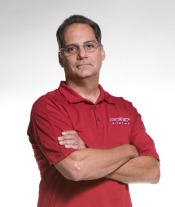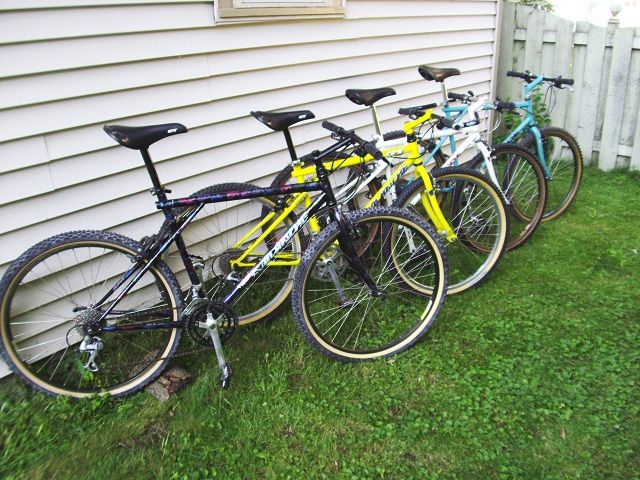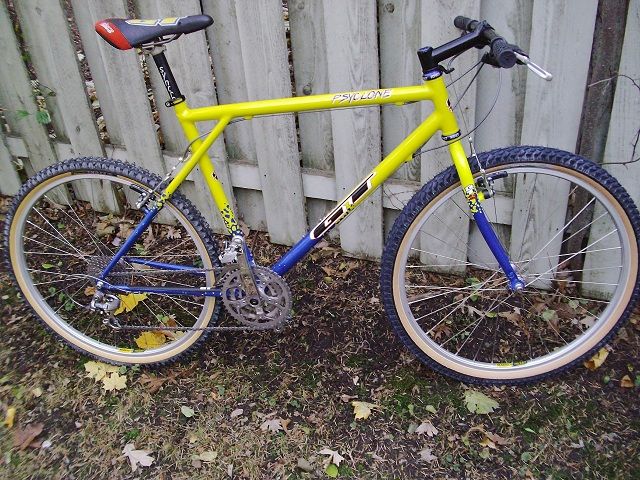
1) Retrobike: A bit about your background. Bill where did you grow up, formal education and where were you in the bicycle industry prior to GT?
Bill Duehring: I grew up in Orlando, FL; I worked in my father’s bicycle shop in Winter Park, FL. in Jr. and Sr. high school. After High School I joined the Marines (long family history). After the Marines I ran a shop called Oakridge bike shop in Orlando, FL. for a short time and took night school at a local Jr. Collage, then I joined East Coast Cycles in Tallahassee, FL. which later became Cycles USA. I was in Sales then moved into Product Development, and developed the Jamis bike line, for Ron Jamis. I was there for 7.5 years when I was recruited to work for GT in 1985.
2) RB: When did you start working for GT and what was the first complete model year of bikes that you worked on?
BD: Started in 1985, worked on 1986 line up through 1999 line up.
3) RB: The GT Zaskar, what year did development begin and how long did it take to get it refined and to market? Were there major hurdles to overcome getting it to the market?
BD: GT first built the Zaskar in 1990 , I’m sure it took months of design and prototyping to develop this frame set, too far to remember all the details. GT’sbiggest hurdle was it used a lot of BMX technology at that time, oversize welds, BB finish, external gussets, plus the triple triangle design which made the frame set stand out.

BD: Yes, this was my idea. I saw and old style lugged triple triangle Cyclocross frame in a magazine, took that idea, designed larger tube sizes, added Tig welding, gussets, and designed the GT triple triangle frame set. Yes, the idea was to design a frame set that would stand out in the market place.
These are a few other designs I did at GT-
-Flip-flop stem with removable face plate.
-Cable crosser which allowed better braking with U-Brake.
-Groove tube which hides the brake cables under the top tube.
-3D adjustable offset fork.
-700D wheel size which is similar to today’s 29ers, it’s really the first BIG wheel MTB bike, it was just way ahead of its time.
-Bringing in custom paint process to the industry: Dakar white, smoke paint, crack paint, tequila sunrise etc, etc., many other unique styles of painting.
5) RB: Trends. In the early days of the sport what were there trends that you followed in bringing changes to geometry or product design? Were they influenced more by product development in the field or ideas coming from part and component manufacturers in Taiwan?
BD: In the early days GT looked at BMX for strength and design ideas, plus we watched the motorcycle industry for durable design parts, brake levers etc. We understood how to design and build a frame set to take punishment, and I used my retail background and experience in the bike industry (plus a lot of rider feedback) for the geometry ideas and changes.
6) RB: Team. In my time working with a GT distributor I was always amazed at the “TEAM” atmosphere from top down that drove GT as a company. Did that come from the top meaning Richard Long or was it something that just naturally happened as a part of existence and survival in an industry that was evolving and changing quickly back then?
BD: Yes, Richard was the driving force for the teams and our racing image; he believed if you raced on Sunday you could design and sell better on Monday.
7) RB: Many people say that marketing drives the bike industry but with so many companies just doing a basic archetype frames and different decals do you feel that items you helped develop like 2x4 and 3D forks, cross over cable guides, flip flop stems and the Groove Tube helped in marketing and made GT bikes standout with features that separated GT from the rest of the industry?
BD: The original GT was product driven, yes marketing was also a huge key to its success. But, bike design and innovation was the driving force behind GT growth and image.

BD: Racing was its lifeblood, produce development (PD) and engineering discussed designs and new ideas with our Team managers and Pros all the time. Remember, GT had many teams at this time, GT/Dyno, Powerlite, Robinsons, GT adult.
9) RB: Who built the first Xizangs? Help us dispel the internet rumours...were the Xizang and Edge Ti ever produced at the Tech Shop for the general public and dealer sales?
BD: The first frame was the Psyclone Chromoly frames, these were handmade at the GT tech shop in Co.. Then the Xizang frame, it had a Ti front triangle with Cro-Mo rear, this frame was made in Canada by a small builder called La Vaue and was located outside of Whistler. 2nd generation frames were made by Sandvik, 3rd gen were made by the GT Tech shop in Colorado.
10) RB: Project 96 was timely in GT’s launch in to the road bike market at a time when road bike sales were lagging in the industry. Was this added exposure helpful for GT?
BD: Yes, Project ‘96 was GT’s push into the road market, this project supported the US Olympic team, plus GT’s launch into the road market.
11) RB: Did Forrest Yelverton and the Tech Shop team ever produce bikes for other companies that received decals other than GT decals? Who were the welders building the frames at the Tech Shop?
BD: No, GT never made frames for any other companies that I knew about .
Welders- this is all I can remember, we had more.
-Dave Tiemeyer
-Mark Nobilette
-Nalby Varoqua
-Dave Norton
-Jason Hamburg
12) RB: In the early days how many people worked in the GT product development department? How many when full suspension ramped up in the industry?
BD: Day one - was Bill Duehring, next step was Bill and Dianne Shaw doing all spec’s for years, then we added Forrest Yelverton and Keith Von Hubben for engineering in Co., then we added product managers Robert Kahler, Brian Wilson and Pete Garski, then we added Jim Busby as an outside consultant for suspension and then Jeff Soucek was added as design engineer, then Mark Peterman came inside to PD Dept.
13) RB: Travel. We all know that product managers within the industry must travel. Are you a good traveller? How have travel abroad for business and IT changes changed the need to travel over the years within the industry.
BD: Travel, if you don’t like to travel don’t become a PD manager. I have travelled the last 30 years of my life for the bike industry. Most of these trips have been for PD or to manage engineers and PD staff; if you add up all of the time I have spent in Asia over the past 30 years it equals 7.5 years of my life. Yes, I’m a good traveller! When I started in PD we used Telex and type writers, then the fax machine came alone, now we have the internet, Skype etc, life is so much easier now than the old days.
BD: NO WAY!!!!
15) RB: In regards to the “vintage/classic /retro market” does the industry acknowledge that there is one? Does the industry feel this market is significant or growing? I ask this because there are many of us in that 40-60 yr old age bracket that have mountain biked for decades. Many of us feel the industry has become to segmented and that all we really want or need in a bike is something similar to what we had back in the late 80’s to early 90’s.
BD: I feel there will always be a retro market here in the USA, both road and MTB, some people just love steel bike frames to ride for example. Another example is people want a bike, a car or a motorcycle from the past, we want to remember our youth, what is better than owning something you remember and loved. I personally believe it will never be a huge market, but a market that does have its place in our industry.
16) RB: Do you or any of your product team follow bike blogs on the web for trends?
BD: Yes, some of our guys follow blogs.
17) RB: Are most of your former GT product development team members still active within the industry today? Which ones and where are they now?
BD: Yes, many of my guys (original GT Bicycles) are still in the industry.
-Brian Wilson and Jeff Soucek- work for me at Felt Bicycles
-Robert Kahler sells for Giant I believe
-Mark Peterman is running the NEW GT Bicycles now
-Pete Garski- is Haro’s National sales manager
-Jim Busby is still designing suspension bikes for GT I believe
1
BD: Yes, I believe if Richard Long was still alive I believe he would of never sold the company. He would have found a way to keep it from falling down. If Richard had lived GT would be one of the biggest US brands in the world today. Yes, I would still be in GT colours if Richard Long was alive. He was my mentor and I respected his hard work, dedication to his company and his passion for bicycles
19) RB: I know family was always important for Bill Duehring. Travel and working in the bike business can make family time difficult. I see one of your sons is working with you at Felt these days. Does it make you feel proud that one of your own would want to follow in your foot steps?
BD: I have three loves, family, bikes and old cars. No question this industry has kept me away from my family, but the time I have at home with my family I try to make it quality time. I grew up in a family business, I cherish the memories of my time working with my Dad, Mom and Brother in our small family bike shop. Yes, I love that my son has come into this company and wants to learn the bike business . My son coming to work for me makes all my hard work over these years worth it to me.
20) RB: How much do you ride these days?
BD: Not as much as I would like, my knees are going bad and I have a bad lower back. But, in the spring and summer months I try to get out on two to three lunch rides a week, plus weekends when I’m not traveling or under a huge work load from running a company.
Thanks to Kevin Sande aka gm1230126 for the words and questions. Thanks to bill Duehring for picture and of course agreeing to do the interview.